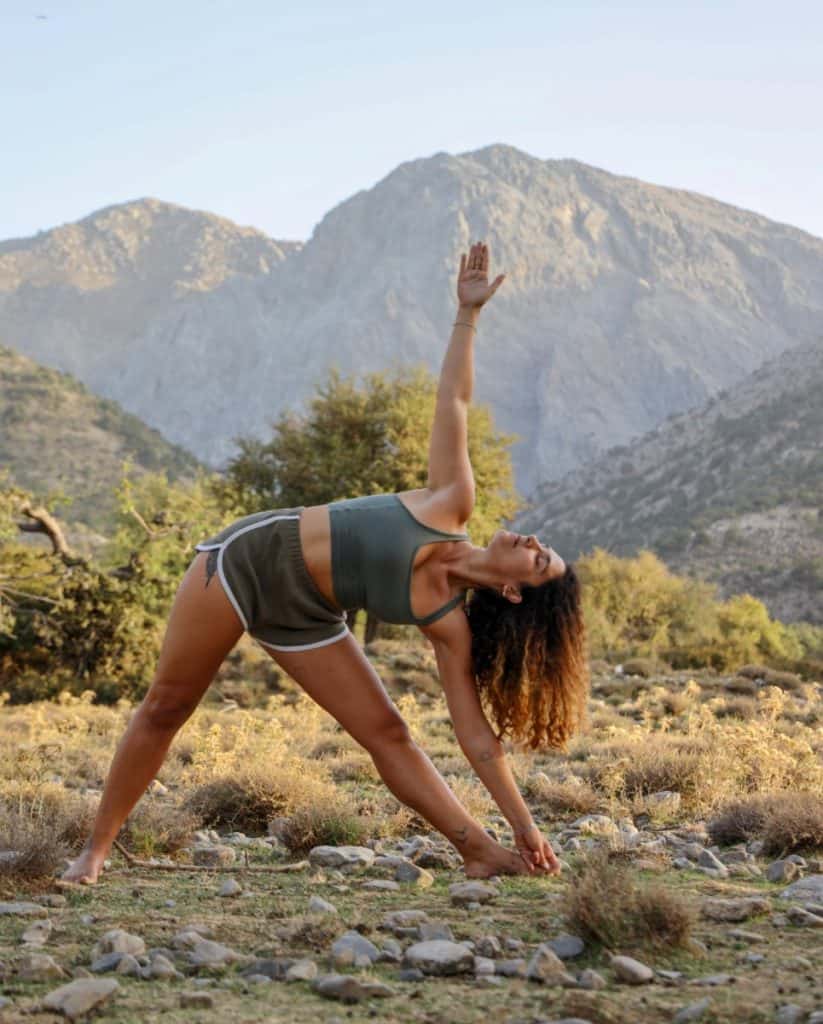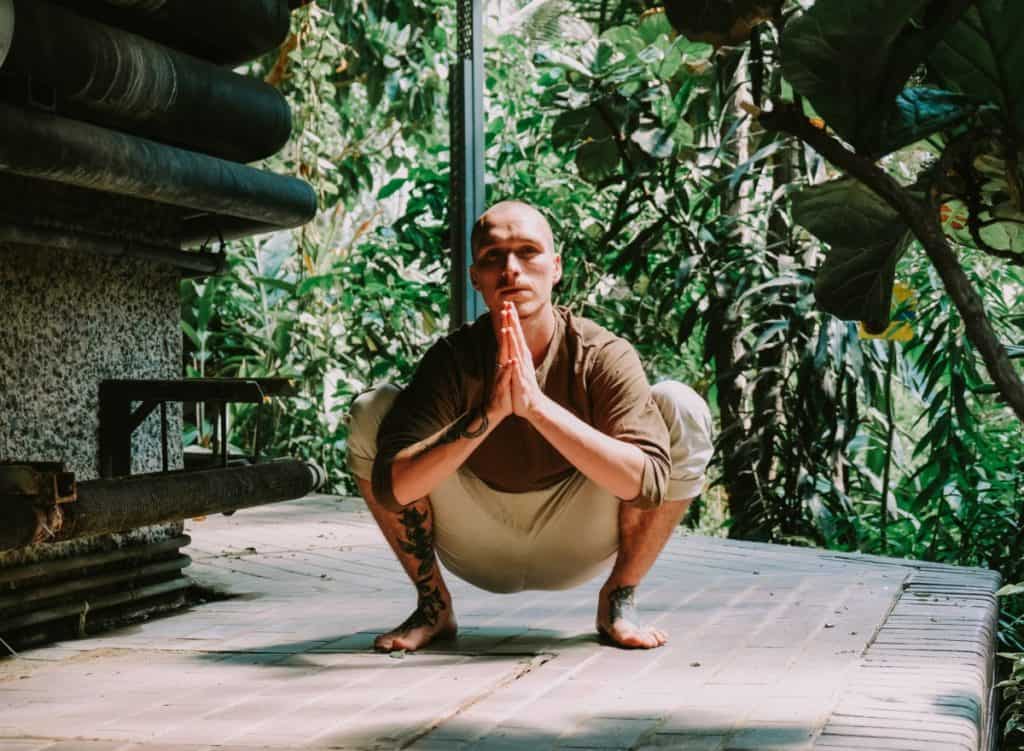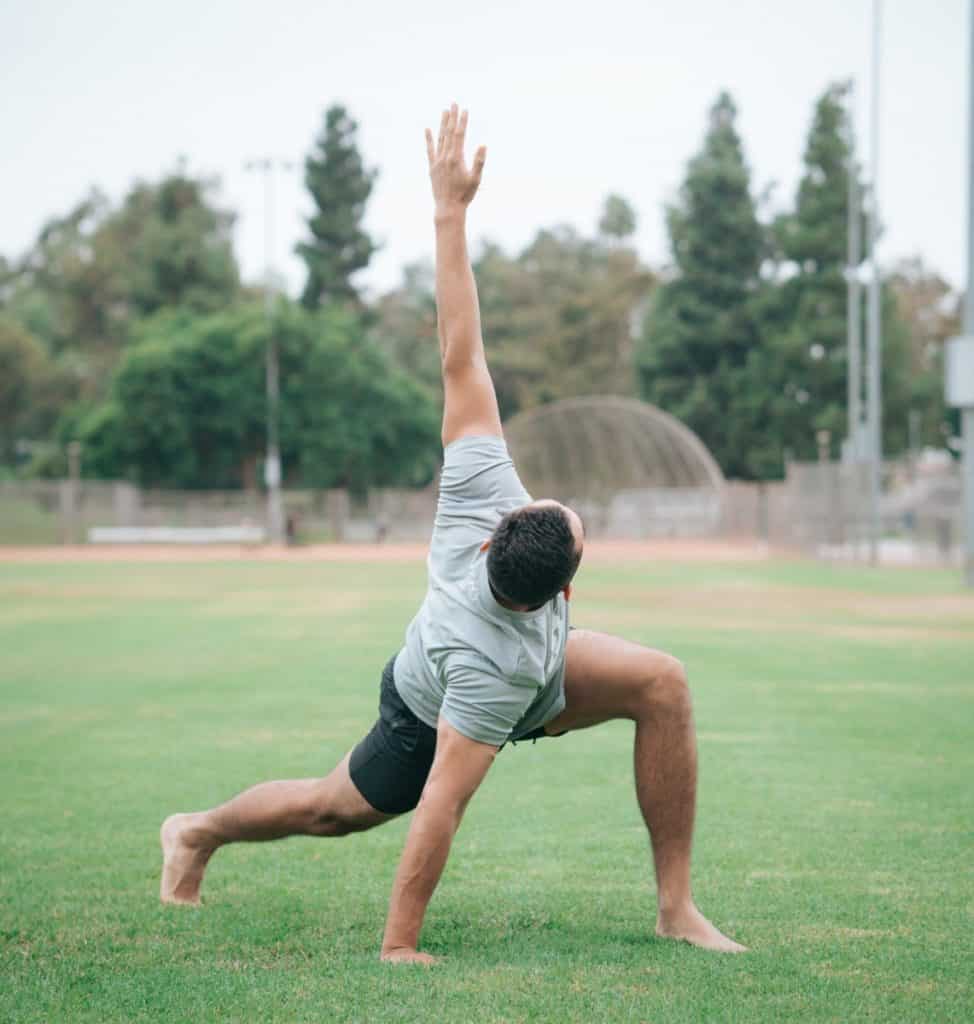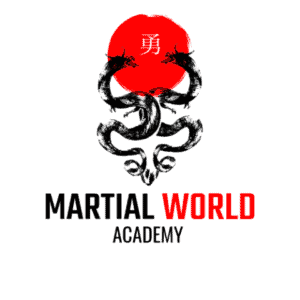This is part 5 of our “Karate Training at Home” series. Click these links for Part 1, Part 2, Part 3 & Part 4
Are you having trouble getting it up? Or maybe stiffness isn’t the problem, but you lack endurance? Don’t worry, this is a very common problem that affects both men and women. That’s right, I’m talking about high kicks (what did you think I meant?).
As martial artists, we need to be flexible. But in our technological world where we might remain seated for 90% of our waking hours, this can be quite a challenge. And it’s common for dojo training to fall short of bringing your flexibility where you’d like it to be. But how to get flexible? What’s the best method? And what if you’re already flexible? What else can you gain from practicing yoga?
For martial artists, yoga can be the perfect supplementary training. With a small time commitment it will certainly help you become more flexible, and it will help you build muscle, heal old injuries, reduce stress, increase focus, and loosen stiff joints.
That’s only the beginning though. Stick around and see what else yoga can do for your martial arts training.

Stretching the Truth – Top 6 Yoga Myths
As an outsider I had a lot of preconceptions about yoga. Some of them true, but most of them cobbled together over the years from hearsay and TV. So when I decided to write this article I did a short survey online of martial artists who had never tried it and asked what they believed about yoga. So here it is, the Top 6 Yoga Myths that hold many martial artists back:
- “True yoga practice requires believing in chakras and other metaphysics.” – Nope! As a martial artist, you can gain every physical and psychological benefit from yoga without believing in any “woo-woo” stuff.
- “You need to be flexible to practice yoga correctly.” – This would be like saying you need to be fit in order to work out.
- “You are too old/young for yoga to benefit you.” – As long as you can move, yoga is for you. And frankly, I think young people might benefit even more from learning quiet and patience as byproducts of a yoga practice.
- “Yoga is for girls.” – I’m not gonna highroad you, perhaps yoga isn’t the most masculine use of time (from the Western perspective). But neither is dressing up in white pajamas. The point here is that (1) you shouldn’t be so concerned with what others think and (2) there’s nothing wrong with doing something that might seem “silly” if it helps you achieve your goal.
- “I don’t have time.” – If you have time to look at your phone, you have time to do a few poses. Seriously, just 10 minutes a day, targeting your tight spots, is enough to get you almost as flexible as you’d ever want to be.
- “Yoga isn’t a good workout.” – Well, if you’re trying to achieve hypertrophy, then yeah. But I can promise you that yoga will physically challenge you. Remember the first day your sensei made you hold a horse stance for an extended period? Yeah, it’s like that except all over your body.

Benefits of Yoga for Martial Artists
Now that we have the myths out of the way, let’s talk about the truth. Why should you devote a portion of your training time to something gentle like yoga?
- Yoga provides improved balance – Want better kicks? Having trouble with a tricky kata? Need to be more resistant to take downs in sparring? Yoga can help.
- Increased strength and endurance – Particularly true for grapplers and anyone interested in preparing for real self defense, isometric training is hugely valuable. You will be training to hold your muscles tight under stress for extended periods of time, just as you would if you were grappling in the street or on the mat.
- Joint health – Young bloods don’t think about this until they’re injured, but us older guys know the value of joint health. It’s like oil for your engine – keeps the moving parts moving smoothly. Yoga, through it’s myriad of “weird” poses, allows neglected and overworked joints alike to be lubricated and loosened.
- Mental Clarity – Holding balance poses requires a quiet mind. Even if you have no interest in the spiritual aspects of martial arts (like me), you acknowledge that a quiet mind is a focused mind. And a focused mind is a dangerous one; perfect for anyone looking to sharpen their “weapon”.
- Better Breathing – In sparring it’s easy to get “gassed” and this often means you need to spend time training your breath. Breathing is a special part of yoga training. If you need breath work, practice yoga.
- Breaking a plateau – Have you reached a plateau in your martial arts training? Yoga practice can help you break through and dig deeper into your art.

Schools of Thought – 7 Popular Styles of Yoga
Just like martial arts, there are many styles of yoga. Again, like martial arts, each main style has sub-styles, too. And again, just like martial arts, you need to choose a style of yoga that supports your goals. But which one? How can you tell which one will support your goals without a huge investment in time?
Now, I’m quite far from an expert in the field, but I have come across seven common types of yoga. Use this quick guide to help determine which one is going to help you best in your at home Karate training.
- Hatha (Force Yoga) – Poses are slower in this form of yoga, to allow for meditation while moving and holding. Good for beginners to yoga.
- Ashtanga (8-limb Yoga) – Adherents tout its weight loss abilities, along with back pain relief. Teaches strong flexibility and physical balance.
- Vinyasa (Flow Yoga) – All your muscles get equal attention through a more constant flow of movement. Perhaps better for martial arts in general due to its more active pacing.
- Kundalini (Circular Yoga) – This is the stereotypical type of yoga you might have seen on TV. Lots of “Ohmmms” and meditation. Unless you’re pursuing the spiritual side of martial arts, this might not be the one for you.
- Iyengar – Very good for beginners and those training with injuries, as it uses many popular props (blocks, bands, chair, etc) to aid in performance and avoid injury.
- Yin (Internal Yoga) – Like Hatha, Yin is slower and more meditative. Poses are held for extended periods of time which, for some, can be boring, but designed to strengthen fascia and connective tissue that is seldom targeted.
- Bikram (Hot Yoga) – The newcomer to the yoga world, popularized in the 1970s. This form of yoga is quite similar to others, except you perform it on the surface of the sun. The extreme heat is designed to help you “cleanse impurities” and lose weight(?).
So which one is best for you? That depends a great deal on what you’re trying to improve and your current familiarity to yoga as a whole. My advice would be to start with Vinyasa or Iyengar, but try each of them. And don’t be afraid to take poses from several forms and create your own routine, too. As one wise man once said…
Absorb what is useful, reject what is useless.
Bruce Lee
How Often Should You Train in Yoga?
The hard and fast rule is that there isn’t a hard and fast rule. If your goal is to loosen your hips, then that will require a shorter commitment of time than desiring to get physically stronger. (And if you’re searching for spiritual enlightenment you might never get up off that foam mat!)
These kinds of questions are further complicated by a host of factors, such as: what your current level of fitness is, whether you have any physical injuries or impairments, your own ability to stick to a new habit, etc. However, if we imagine a typical martial artist (if such a thing even exists) then let me try to give you some minimum guidelines for how long you may need to train in order to achieve some common goals.
| Goal | Duration | Frequency |
| General Flexibility | 15 min | 3x per wk |
| Weight Loss | 30 min | 5-6x per wk |
| Stress Relief | 10 min | Daily |
| Build Strength* | 1 hr | 3x per wk |
| Mental Clarity | 10 min | 1x per wk |
*If building muscle is your goal, you’ll definitely want to see Part 4 of this At Home Karate Training Series. Click the link to check it out!
Where to Begin?
Hopefully by now you’re sold on implementing yoga into your training regimen. So where to begin? While I think you definitely should try a few yoga schools in your area, there’s no guarantee that the yogi (instructor) will have the same goals for your practice that you do. And, if you’re anything like me, you don’t want to look foolish in front of a group of strangers, so showing up and being a total novice might be a bit too much.
Instead, I recommend starting in your own home. And, lucky for us, YouTube has more yoga content than you could ever possibly watch. And to help you get started, I’ve broken them down into goals, like the previous section.
General Flexibility
Weight Loss
Stress Relief
Building Strength
Mental Clarity
Final Round
As you can see, for the martial artist, yoga has a myriad of benefits and most of them are achievable with a very small time commitment. Whether you’re looking to build strength, create focus, gain flexibility, lose weight, reduce stress, or simply become a more capable martial artist, yoga has you covered.
Photo Attribution:
- Photo by Patrick Kool on Unsplash
- Photo by Mor Shani on Unsplash
- Photo by Benn McGuinness on Unsplash
- Photo by Dex Ezekiel on Unsplash
